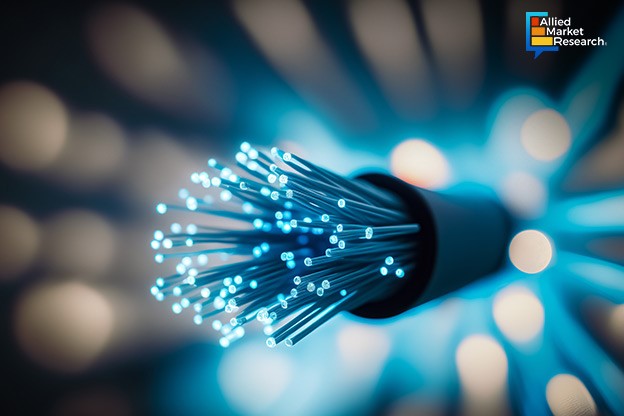An Analysis of Innovative Opportunities Optical Fibers Are Bringing to The Telecommunications

8 Jul
2024
Highlights:
- Introduction
- High bandwidth, low attenuation
- Immunity to electromagnetic interference, and security
- Impact of optical fibers on telemedicine
Optical fiber is a thin, transparent filament made of glass or plastic to transmit data as light pulses. It offers high bandwidth, low signal attenuation, and immunity to electromagnetic interference, making it integral for high-speed telecommunications networks and various industrial applications. In modern telecommunications, it sends out data over long distances with minimal signal loss. It enables high-speed and high-capacity communication networks, supporting internet services, telephony, video conferencing, and other digital applications essential for global connectivity and information exchange. Since its development, optical fiber has not only transformed the speed and reliability of communication networks but has also created innovative opportunities.
High bandwidth, low attenuation
Optical fiber provides high bandwidth by utilizing light waves to transmit data. Contrary to traditional copper cables, which are limited by electrical resistance and interference, optical fibers carry a significantly larger volume of data over long distances. This supports high-speed internet, digital communications, and multimedia applications without compromising signal quality. For example, Fiber optic networks can deliver symmetrical upload and download speeds of up to 1,000 Mbps (1 Gbps), enabling seamless streaming, rapid file downloads, and smooth online gaming experiences concurrently for multiple users. As a result, optical fiber is important for meeting the growing demand for faster and more reliable data transmission in modern telecommunications networks.
Huawei Technologies Co., Ltd., a global leader in telecommunications and optical fiber technologies, collaborated with Saudi Telecom Company (STC) in 2020. The collaboration focused on positioning advanced optical fiber networks across Saudi Arabia. Huawei's optical fiber solutions facilitate seamless telemedicine consultations, diagnostic imaging, and remote patient monitoring in Saudi Arabia's healthcare system.
Optical fiber also provides low attenuation, which implies that light signals can travel long distances without a significant loss in signal strength. It allows data to be transmitted reliably over thousands of kilometers without frequent signal boosting or regeneration. It ensures high-quality communication and is required for long-haul telecommunications networks and undersea cables. For example, data transmission across transoceanic cables spans thousands of kilometers under the ocean, yet they maintain signal integrity with minimal attenuation. It enables reliable and high-speed data transfer between continents, supporting global internet connectivity, international communication networks, and submarine cable systems essential for global data exchange.
Immunity to electromagnetic interference, and security
Optical fiber's immunity to electromagnetic interference (EMI) stems from its use of light signals for data transmission rather than electrical currents. This characteristic makes optical fibers resistant to disturbances caused by nearby power lines, radio waves, or electronic devices. As a result, data transmission through optical fiber remains stable and reliable even in environments with high electromagnetic activity, ensuring consistent performance and minimizing the risk of signal degradation or interruption. The networks can also reliably transmit data through environments filled with electromagnetic noise from power lines, radio waves, and electronic devices without compromising signal quality. It ensures consistent and secure communication for businesses, residential users, and complex infrastructure, demonstrating the robustness of optical fiber in mitigating EMI challenges in modern telecommunications.
Furthermore, the inherent security features make optical fiber ideal for transmitting sensitive information, such as financial transactions and government communications, safeguarding data against eavesdropping and unauthorized access. It ensures privacy and integrity in digital communication networks, to maintain trust and confidentiality. Besides, they facilitate secure and low-latency transmission of trading data between financial centers and stock exchanges. The inherent difficulty in tapping into optical fibers ensures that sensitive trading information remains confidential and protected from interception, safeguarding against potential breaches, and ensuring the integrity of financial transactions in real-time global markets.
Impact of optical fibers on telemedicine
Optical fiber’s ability to carry large volumes of information securely and swiftly ensures seamless communication between healthcare providers and patients, assisting in remote diagnosis, monitoring, and treatment. The technology has massively transformed healthcare accessibility, particularly in remote areas, enhancing patient care, reducing healthcare costs, and facilitating timely medical interventions globally. Furukawa Electric is a prominent company in the optical fiber industry that has supported telemedicine initiatives. Their optical fiber cables and components have been utilized to establish robust and secure communication networks for telemedicine applications. In 2017, Verizon Communications collaborated with Corning Incorporated to invest $1.05 billion in installing optical fiber solutions. The partnership aimed to expand Verizon's fiber-optic network infrastructure, enhancing connectivity and capacity for high-speed broadband services.
Summing up
Whether enabling high-definition video calls, strengthening global internet connectivity, or advancing research in quantum communication, optical fiber has brought significant reformation to the telecommunication industry. Offering maximum speed, reliability, and capacity for data transmission, optical fibers have become indispensable global infrastructure. However, efforts are ongoing to reduce its environmental impact through sustainable manufacturing practices and recycling initiatives, paying way for a greener future for the next generations.
For more industry updates and other important insights on optical fibers, contact our experts now!

Koyel Ghosh
Author’s Bio- Koyel Ghosh is a blogger with a strong passion and enjoys writing in miscellaneous domains, as she believes it lets her explore a wide variety of niches. She has an innate interest in creativity and enjoys experimenting with different writing styles. A writer who never stops imagining, she has been serving the corporate industry for the last five years.
Avenue: Entire Library membership of Allied Market Research Reports at your disposal
- Avenue is an innovative subscription-based online report database.
- Avail an online access to the entire library of syndicated reports on more than 2,000 niche industries and company profiles on more than 12,000 firms across 11 domains.
- A cost-effective model tailored for entrepreneurs, investors, and students & researchers at universities.
- Request customizations, suggest new reports, and avail analyst support as per your requirements.
- Get an access to the library of reports at any time from any device and anywhere.
Related Post
-
How are Submarine Cables Transforming Global Connectivity with Enhanced User Experience?
-
Endoscopy Procedures: Transformations in Techniques and Applications
-
AI-Powered Video Analytics: How the Product Actually Works for enterprises
-
Painting Robots: Transforming Precision Coating and Creative Applications
-
Innovations in Pharmacovigilance Systems Advancing Patient Safety
-
Understanding Edge Security: Keeping Data Safe Near the Source
-
Exploring the Use and Advancements of 3D Laser Scanners in Professional Applications
-
Reinforcing Industrial Controls with Smarter Tools and Training








